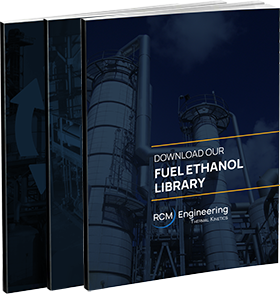Evaporation Equipment
Evaporation technology is used in any process that requires concentration of a stream by removal of water or other solvent. The process of evaporation is energy-intensive; any evaporator system design approach needs to take great consideration into the heat recovery philosophy and overall utility usage of the final system design. Product characteristics also need to be considered in the system design; many product characteristics can be altered in an evaporation process, especially in a Food and Beverage application.
Evaporators are used across an array of industries, such as:- Chemical Production
- Food and Beverage
- Pharmaceutical Production
- Agricultural Chemical Production
- Pulp and Paper
- Oil and Gas
- Fuel Ethanol
- Chemical Plant Waste Systems
- Removal Of Solvents From Oils
- Cannabinoid Oil Refining
- Pharmaceutical Product Recovery From Waste Streams
- Gelatin Production
- Concentration Of Sugar Solutions
- Sodium Hydroxide (NaOH) Production
- Sulfuric Acid Production
- Phosphoric Acid Production
- Evaporative Crystallizers For Salts
- Brewery Waste Concentration Systems
- Chemical Recovery In Metal Plating processes
Types of Evaporators
There are several varieties of evaporator designs commonly used throughout different industry sectors. The selection of the appropriate design is based on many factors that consider the efficiency of the system and the appropriate use of a specific evaporator type to maintain final required product characteristics. Within the framework of the system design is the selection of the appropriate equipment within the design. The main piece of equipment used at the heart of the evaporation process is the evaporative heat exchanger. The varied system designs can utilize different technologies within the evaporator system. The two main technologies used in an evaporator design by Thermal Kinetics include:
Tubular Evaporators: A shell and tube heat exchanger is used to drive the evaporation process. The specific detailed design of the shell and tube results in a variety of evaporator system configurations that include:
- Falling Film Evaporator
- Rising Falling Film Evaporator
- Flash Evaporator
- Forced Circulation Evaporator
- The plate heat exchanger is relatively easy to disassemble, inspect, and clean.
- Depending on the process fluids a higher heat transfer coefficient is achieved.
- The compact heat exchanger area reduces the overall system size and headroom requirement
- Lower installation cost
All Products
-
Fuel Ethanol PlantsFuel Ethanol Plants
-
Adsorption EquipmentAdsorption Equipment
-
Evaporation EquipmentEvaporation Equipment
-
Industrial Distillation EquipmentIndustrial Distillation Equipment
-
Crystallizer EquipmentCrystallizer Equipment
-
Specialty Process SystemsSpecialty Process Systems
-
Modular SystemsModular Systems
Care needs to be taken in fouling applications due to the small gap used between heat exchanger plates. The use of plate evaporators must be carefully chosen as some problems can arise in the case of mineral fouling and corrosive service.
One corrosive service that is known to be a great problem is using plates for caustic soda evaporation in nickel plates. The hydraulic forces cause rubbing at the plate contact points removing the protective oxide layer and resulting in quick corrosion of the plates.
Evaporator System Designs
Forced Circulation Evaporators
Forced circulation evaporators use a high rate of recirculation within the heat exchanger and separation vessel. This type of evaporator is most suitable for applications with viscous solutions or high fouling products (the accumulation of deposits on the heat transfer surface area that inhibit proper heat exchange from the utility to the process). The fluid that is recirculated is continually heated above the saturation pressure in the separator and flashes into the vessel forming the process vapor. A forced circulation evaporator is commonly used in crystallizer designs. A forced circulation evaporator is a more robust design compared to a film evaporator. There is viscosity-limitation for film evaporator designs, which is due to film breakdowns that cause the formation of dry spots on the exchange tubes. The forced circulation design overcomes the viscosity limitation and provides a high level of control and stability as well as significant reduction of fouling.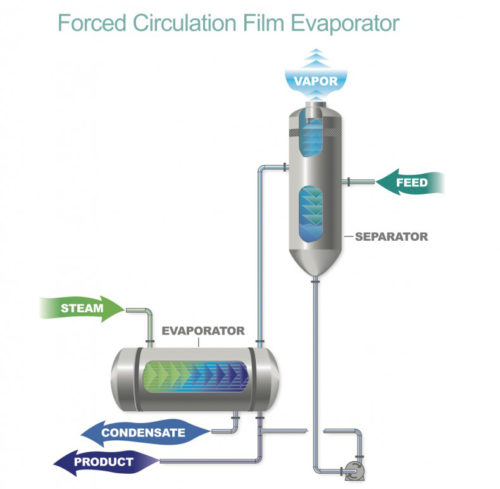
Forced Circulation Crystallizer
The forced circulation evaporator design philosophy is also used in several configurations in industrial crystallizer applications. A wide range of industrial chemicals and inorganic salts require robust crystallizing evaporation systems. The feed fluid is introduced into the system and is recirculated and heated to the boiling point. Over time the product is gradually concentrated in the system until the required concentration and crystal size parameters are achieved. The size of the crystal is a function of the residence time (RT) allowable by the size of the vessel. It is desirable to run a testing protocol in the design phase to determine the optimum RT associated with the desired crystal size.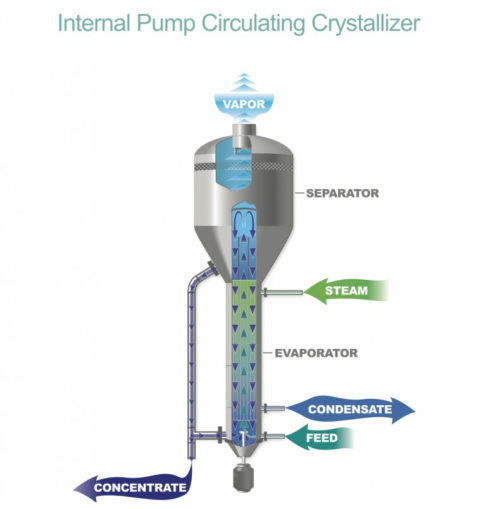
Film Evaporators
Film evaporators are among the most cost-effective evaporation systems in use today. They also provide very high heat transfer coefficients (HTCs). However, they can have a greater fouling propensity as opposed to forced circulation evaporators, which in turn, limits their effectiveness in some applications.Falling Film Tubular Evaporator
A falling film evaporator is considered the “most gentle” evaporation system design. A very short residence time and efficient heat transfer are the main benefits of this design and contribute to the perceived “gentle processing” nature of the design. In the operation of a falling film evaporator, fluid is pumped to the top of the heat exchanger and is evenly distributed across the tubesheet and into the heat transfer area. Proper wetting of the heat transfer area is required to maintain the dynamics of the evaporation process. Improper wetting from low flow or maldistribution into the tubes results in dry spots and fouling inside the tubes. Because of the efficiency of the falling film design, it is commonly used in large systems since the heat transfer required area is reduced and thereby overall system cost. The low difference in steam and product temperature (ΔT) allows for a greater usefulness of the Multiple effect evaporator design philosophy. It is not uncommon to see 5–7 effect falling film evaporator designs.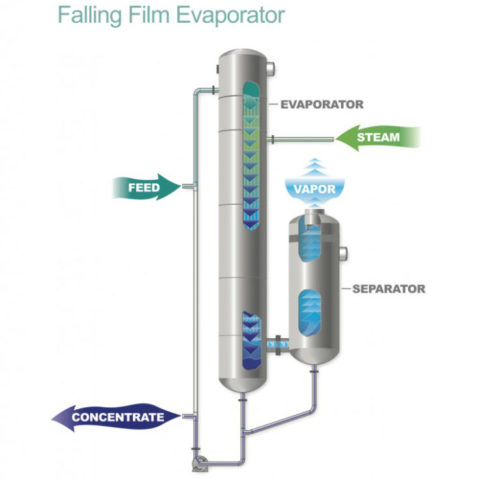
Rising/Falling Film Tubular Evaporator
A derivation on the falling film evaporator design that is useful for specifications limiting overall system height is the rising/falling film design. Thermal Kinetics employs a proprietary rising/falling evaporator design. Besides the reduction in height, the other benefit of the rising/falling film design is the elimination for the additional pumping head and piping used in a falling film evaporator design. Thermal Kinetics’ proprietary design works as follows:- A small portion of the tubes in the evaporative heat exchanger is used in the rising pass.
- This initial boiling pass generates a high velocity two-phase stream of liquid and vapor.
- The liquid vapor stream self-distributes across the tube sheet to the falling film pass.
- As a result of the design, fouling and plugging at the top tube sheet is greatly mitigated.
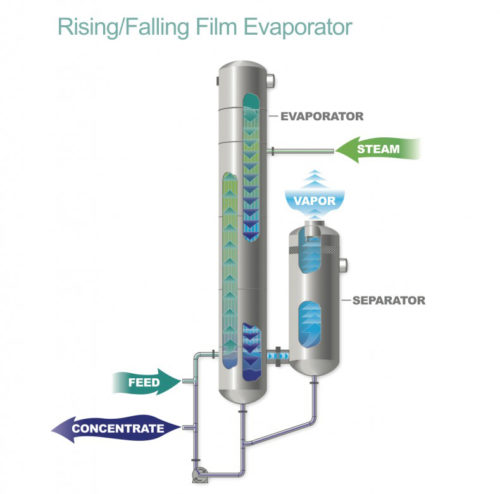
Rising Film Evaporator
One of the very early “modern” evaporator designs, a rising film evaporator utilizes either a plate heat exchanger or a vertical shell and tubular heat exchanger with process fluid in the tubes. As the liquid boils, it creates a film on the inside of the plate or tube as a consequence of the vapor volume generated. As with any film style design, the resulting heat transfer coefficient makes the design very efficient in terms of heat transfer area required. This system operates by natural circulation thermo-siphon action and thereby eliminates the need for large recirculation pumps; alternately, it can operate in a single pass as shown below. The upward force of vapor produced by the boiling liquid pushes the rising liquid into a thin film with a great amount of turbulence. The system hydraulics offer an advantage for processing more viscous products. Rising film evaporator are compact designs that offer very simple operation compared to other designs.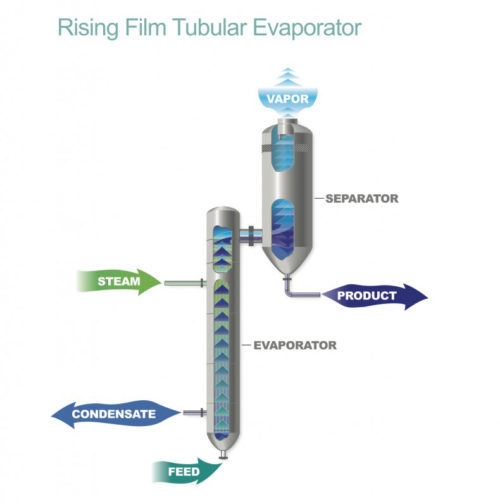
Energy Efficiency and Evaporator Configuration
Evaporation is an energy intense process. In the design process, careful consideration must be taken to use a design that is not only appropriate for the fluid being processed but also considerate to energy conservation. Multiple Effect Evaporation The entire evaporator duty (amount of water or solvent being removed) can be segregated into multiple evaporator effects. The segregation of the duty is combined with a pressure gradient across the entire evaporator to allow for reuse of energy in the system. The figures below show how the multiple effect design concept functions. In essence, the steam economy of the system is linear to the amount of effects used in a design. Depending on process limitations, multiple effect designs are typically limited to approximately 7 effects.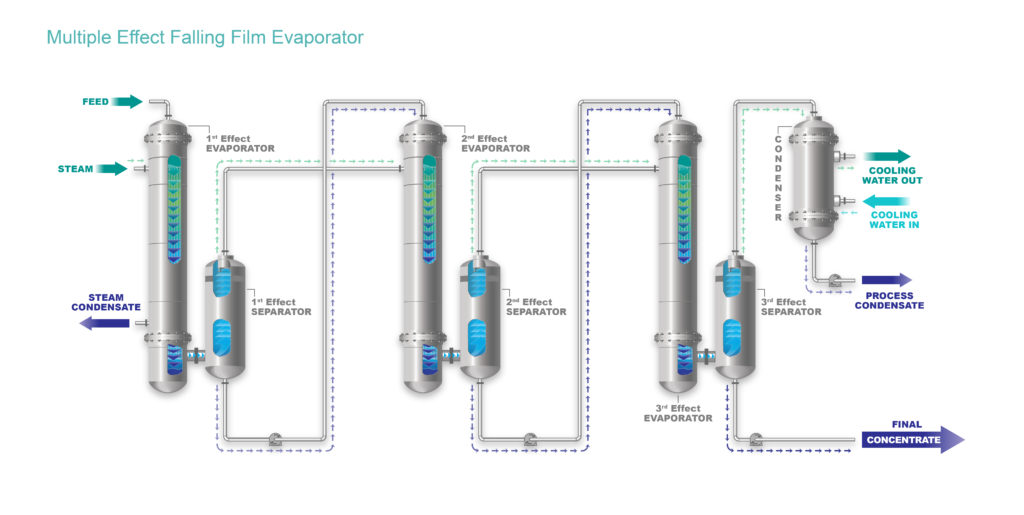 Thermal Vapor Recompression (TVR)
TVR can be used on a single effect evaporator to increase the steam economy or in conjunction with a multiple effect design to further enhance the system’s steam economy. TVR uses high-pressure steam in conjunction with process vapor to drive the evaporation process.
Thermal Vapor Recompression (TVR)
TVR can be used on a single effect evaporator to increase the steam economy or in conjunction with a multiple effect design to further enhance the system’s steam economy. TVR uses high-pressure steam in conjunction with process vapor to drive the evaporation process.
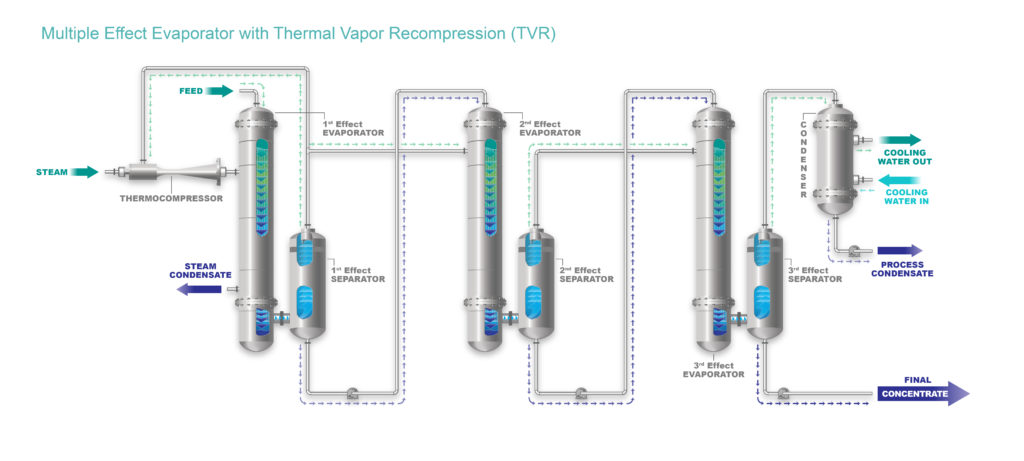
Mechanical Vapor Recompression (MVR)
MVR designs utilize a compression device to increase the pressure of the process vapor and reuse it as the heating medium for the evaporator. Typical mechanical devices used in an MVR design are: centrifugal fans, compressors, and blowers. MVR designs can theoretically provide the efficiency of 100 equivalent effects of a multiple effect evaporator design. The cost of electricity to drive the compression is a factor in the equivalent effect comparison.
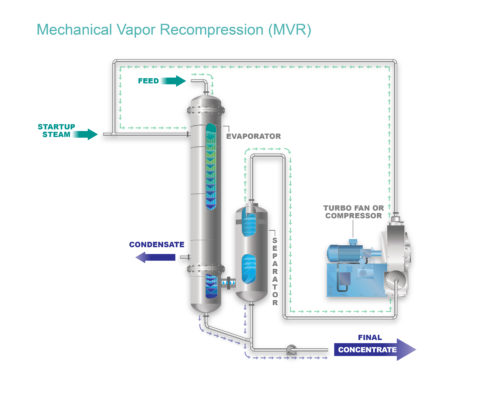

Materials of Construction
There are two major factors to consider in the material selection process for an evaporation system: corrosion and cleaning. Evaporators usually operate under harsh environmental conditions. They may process corrosive fluids that may contain chlorides, acidic agents, or caustic chemicals. For that reason, it is imperative that evaporators are constructed from durable and resilient materials. The following examples demonstrate the importance of material choice:- Stainless Steel Some applications demand high levels of hygiene, so they must bear frequent cleanings and exposure to caustic or acidic cleaning chemicals. Many manufacturers use 304 and 316 stainless steel for hygienic evaporators. They polish surfaces with which the product will come into contact, ground welds for optimal smoothness, and construct piping and other pieces of equipment according to specific codes.
- Other Metal Alloy
Thermal Kinetics employs a number of specialty metals depending on the application. Some examples include:
- Titanium: Calcium chloride and other halogen salt solutions
- Duplex stainless steel: Lower concentration neutral salt solutions
- Nickel: Caustic soda and caustic potash
- Hastelloy: Phosphoric acid evaporators
- Graphite Graphite features a high level of corrosion resistance against common acids and solvents, including sulfuric acid. Thus, it is an excellent choice as a source material for the construction of a sulfuric acid evaporator, since it can prevent heat exchanger corrosion and also provide an adequate level of heat transfer.Consult with Thermal Kinetics for other services. In many cases there are industry proven selections. In other cases corrosion testing is required to find the best choice.
Definitions, Concepts, Operational, and Product Characteristics
When sourcing evaporation machinery, it’s important to understand the terminology surrounding the processes and products. The following terms will help you foster an understanding of the evaporation process and the equipment used to facilitate it.- Heat Sensitivity. Some chemicals or food ingredients are altered by varying degrees of exposure to heat. If that is the case, evaporation temperatures can be reduced by operating the system at lower pressures. Decreasing fluid volume and retention time of the process fluid inside the evaporator also benefits products with sensitivity to heat.
- Fouling. This term refers to a gradual buildup of solid deposits on heat transfer surfaces. Initial signs of fouling are increasing operating pressures. Secondary indication of fouling is the increase in the steam pressure to the system. If ignored, fouling causes product “burn-on” on the heat transfer surface resulting in system shutdowns for cleaning and maintenance purposes.
- Foaming. This is a common byproduct of the evaporation process. While potentially harmless, excess foam in the system will cause carryover of product to the system condensate. Ways to minimize the negative effect of foam include increasing tubular vapor velocity, spraying the solution onto the foam, or adding an anti-foaming agent.
- Boiling Point Elevation. At atmospheric pressure, water’s boiling point is 212° F. However, dissolved solids can increase the actual boiling point. Dissolved solids such as salt and caustic soda have a drastic impact on the boiling point. For example, the boiling point of 30% calcium chloride is 230° F at atmospheric pressure. Variations like this must be considered in the evaporator pressure and temperature profile.
- Reactivity. Materials in the process of evaporation may sometimes be subject to chemical reactions at particular temperatures or concentrations. If these reactions are undesirable, it’s important to avoid the process conditions that will lead to those specific circumstances.
- Viscosity. Viscosity is a measure of film thickness, or a liquid’s resistance to deformation. Increases in liquid viscosity correlate to overall reduction in heat transfer coefficients. The configuration of a multiple effect system, as well as the setup of contracting methods, can optimize evaporator performance when dealing with high viscosity fluids.
- Heat Transfer Fluid. Evaporators using steam to drive the evaporation process require less heat transfer area than hot oil-heated evaporators. However, if the target material undergoing the evaporation process is not heat sensitive, hot oil is often the better option, since the oil’s temperature can be higher than steam temperatures, reducing the required amount of overall heat transfer area for the system.
- Shell Side Vapor Velocity. Evaporator tubes and heating jackets (the shell side of a tubular evaporation system) must pass vapor at precise velocities to bolster the elimination of non-condensable gas, or air, and promote the development of good vapor shear.
- Wetting Rate. Lubrication of the process side heat transfer area in an evaporator is an essential design aspect of the evaporation process. This is especially true in a falling film evaporator. There must be a sufficient fluid to achieve a proper wetting rate. This wetting rate decreases the risk of fouling, as well as the buildup of solids on heat transfer surfaces.
Selecting the Right Evaporator
With so many factors to analyze, it may seem very daunting to select a suitable evaporator for your specific industry and application. Thermal Kinetics is here to help you navigate the evaporator selection process from start to finish. We provide a wide-ranging selection of evaporators, industrial distillation equipment, and industrial scrubbing equipment.
If you’d like to learn more about the products and services we offer, reach out to us today to request a quote.


